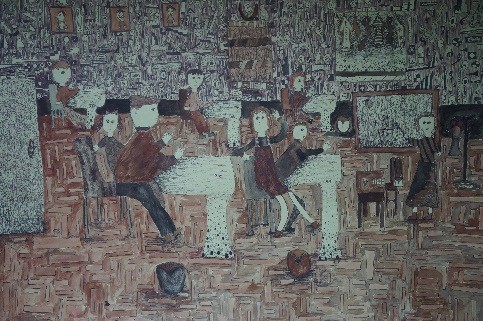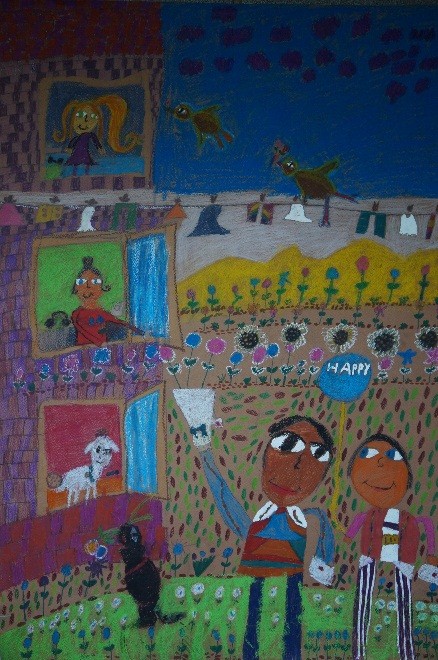Notes on the Contest “In My Homeland”

On January 30 - February 1, 2018, the jury of the 13th International Contest of Painting and Graphics “In My Homeland” was working at the educational centre of the Green Cross Belarus.
The International Contest of children’s fine art “In My Homeland”
- helps to develop artistic and creative potential of every child;
- bring children to solving various artistic tasks;
- contributes to the development of the need for artwork;
- introduces artistic achievements and gives an opportunity to share international methodical experiences;
- allows seeing general trends in modern art education;
- attracts attention of the society to the importance of developing creative needs of children.
This is the wonderful meaning of the Contest.
Eleven thousand works were submitted to the 13th Contest. Along with the dismissed works, there were many others of a high artistic level.
The Contest’s jury rejected more than 7,000 drawings out of 11,000 works submitted. A part of those who continued competing in the Contest got acknowledgement, another one – diplomas of participation, and a tiny group of works awarded medals and became laureates of the Contest that would participate in the presentation of the Contest’s results.
The work of the jury is finished. The most expressive works are selected but the questions “Why have these works been selected? Why are they thought to be good?” are always heard persistently after the announcement of the results.
What is a contest work? What is a selection criterion?
The question of impartiality of criteria permanently arises during the process of assessing children's works because of their specific features that differ them from professional art. Assessing the specific character of children's artistry is a difficult task even for professionals.
What conditions are important for the proper selection of contest works?
It’s significant that a jury board consists of those people who are able to speak the same language, to hear and to listen to each other.
It’s significant that members of the jury board are united regarding the understanding the specific character of children’s art in a psychological, aesthetic and pedagogical aspects.
It’s significant that there is unity in choosing an assessment criterion to evaluate children’s artistry that allows to argue an aesthetic assessment of a child’s painting.
It’s significant that children’s works are selected by the jury not in a formal manner but with emotional response and delicately, carefully and slowly.
A child grows up, and a way of his/her perception and thinking changes. His/her works always have features of the age specificity and, therefore, it is necessary to take into account the age features of children's creativity as precisely as possible as it’s characterized with a unique way of expressing.
This artistic uniqueness is connected with the non-typical nature of the child's perception, the object-functional nature of a child, and with the fact that a child refers to everything in the world as to the living.
This is why the system of expressing, ways of creating an image and assessing paintings of children aged 5-10, differ sharply from the academic model of the image and ways of its evaluation.
What children create is an artistic value (unless adults interfere, of course). A child, aged 5-8, has strongly vibrant sensitivity to artistic creativity and colours. He/she creates paintings as a great master. He/she conveys his/her relation to the image through an expressive colour, form. He/she does it sincerely, directly and in his/her own way!
Therefore, the assessment criterion contains the main aspect:
HOW MUCH OF THE CHILD is there in the work being considered?
Is there an emotionally valued attitude to what he/she creates?
Is there artistic transformation of a child’s life experience in his/her work?
Most of the works sent to the Contest were created without taking those criteria into account, and obviously there was no preliminary selection in schools.
You do not need to send a child’s work to the contest, if it does not touch you, bring joy or grieve, or if you look at it boringly and tiresomely. Even if it is perfectly made, this is also not a reason to participate in the contest. Vice versa, a work can be naive, amateurish, but it can ring a bell in your soul and be alive - this is the main indicator for sending a work to the contest.
There were many works where compositions had been composed exclusively with the use of the plot and its serving subjects. In teaching, there was not a task of creating an image in the language of artistic means. Age peculiarities of a child were not taken into account. The metaphorical nature of art was violated. Therefore, such works looked standard and faceless with lack of individuality. Naturally, the jury board rejected them.
Moreover, there were many works in which kitsch “blossomed” (again, it was interference from the side of parents or teachers, imposing someone’s own taste preferences).
What is kitsch in children’s art?
It is when nobody has taught a child to admire, to see the beauty of the surrounding world with his/her own eyes, to see everything as the living and the figurative. However, someone has made children think that a vision of beauty implies vulgar, cute images of bunnies, kitties with bows, sweet little children with unchildish “darting glances”, with sparkles, roses, and all this external buffoonery of “beauties”. The jury did not consider such works.
There was another direction in children’s paintings that had been also imposed by adults – “an automatic surprise”. I mean absolutely different artistic techniques taken from different art genres are used when creating a work. For example, a background is created by pictorial means (a brush, gouache); a part of a girl’s figure is marked using graphic lines in combination with untouched white parts of the sheet; another part of the figure is created picturesquely; a bouquet she holds in her hands is marked using printed forms. Such works do not have integrity, natural conformity of forms, and therefore, there is not imagery. The jury also dismissed such works despite their external glossiness.
Сopies of watercolor works of contemporary artists continue arriving to the contest, however, their quantity is smaller. Luckily, a lot of them can be found on the Internet. This time the jury has seen copies of watercolor works by A. Costagnedo and Dzh. Zbukvich that were also rejected by the jury.
There was another topic to discuss – use of colour paper in children’s works of deep colours such as bright pink, red, green, etc. Colour paper itself is flat, indifferent, and not alive – it is mechanical. If there is a lot of its untouched background in children's works, this greatly impoverishes it and restrains further development. The child makes several lines or spots and does not know what is next. If you take this colour background away, then nothing can be left from the work. Use of colour paper in children’s works requires great delicacy from a teacher. If children permanently work on color paper without smart management of a teacher, the children learn to work at full strength, do not use the opportunity of fully solve the image in interaction with the environment. The background is here, it is ready, and what you have to do is to fit the idea. The jury considered several children’s works (of the same teacher) created on the pink background, but the ideas were different. Not all the children could choose the same paper of pink colour. How could that happen? A lot depends on a teacher and on how he/she manages the children’s work.



For example, the jury selected the best two works for medals created by the children, aged 5-6, from Armenia, that were also made on a colour ochre background. By the way, this background was developed; tiny ochre particles left by the child somewhere on the background create the necessary rhythm of the image. The colour of the paper and its biggest parts belong to the faces of the figures highlighting and making them the main ones and linking them to the background. The colour of paper made it easier for the child to cope with the colour of a human bod conditionally. As one of the works, even the colour of the paper on the faces is developed what gives them vivacity.
In the composition, THREE SIZES are used – BIG, MIDDLE AND SMALL where BACKGROUND’S COLOUR PAPER IS LEFT. The big one belongs to the figures' faces; the middle – hands and legs; the small – rhythm of spots on the background. Therefore, the paper’s colour helped the child to create desired holistic image.
Paper can be of natural colours (neutral, for example) to organically enter the colour scheme of the composition. Aesthetic education in relation to colour begins with choosing a material. A teacher should take care of that there are no “wild flowers” in the sets of paper for the picturesque compositions that are already self-sufficient and ready for use only in the decorative and applied forms of artwork.
In this case, it is important that a teacher does not give colour paper thoughtlessly, but asked him-/herself why we take it, why this color?
We do it in order to make the work easier and to make a little artist overcome the fear in front of a white sheet of paper, don’t we?
We do it in order to overcome difficulties of work on a white sheet of paper, don’t we?
WHAT IS LEFT AS A COLOUR of COLOUR PAPER IN A COMPOSITION?
There is one important moment more! The work is created using dull colors, but it seems bright because of the colour of the paper. A child has to create this saturated color by him-/herself, learn to work with it without fear but getting joy from it.
It is clear if we draw on white paper. Why can’t we draw on colour paper? Which colour paper should we choose?
The result is that the matter is not in the technique, correctness or uniqueness of works, but in creating a specific desired image that is adequately expressed in colour, form, division of the sheet of paper, and the nature of a smear in any children’s age - in its “golden” period (5-8 years), a transitional one (10-12 years) and a more mature (15-16 years). This should become a teacher's concern!
The main thing is harmonious development of a child’s personality. At school, you must not strictly separate learning and aesthetic education: now we just learn, “turn on” the brains only, and then there will be something alive and interesting, and we will have joy and create! This may not happen, because a pupil student will not be ready to meet with this.
The jury often disagreed on the evaluation of works. I was surprised to note that some of the children's works the jury wanted to remove it as weak ones despite I was delighted and astonished with the children’s artistic findings of those works, their freshness, courage that revealed the authors’ creative faces. After all, creativity is the creation of a new, one's own and unique reality. Actually, creative works should be sent to the contest, not results of drawing classes.
In this regard, it would be great if the Contest had such an award as the Grand Prix.
The Grand Prix (1-3 works) is a child's work which more than others makes adult observers be concerned, causes delight, and shows the originality of the child’s artistic means that is most expressively connected with the image of his/her ideal world.
There is always such a work at the Contest. It teaches others to see in one’s own way, to think in one’s own way, to be a person, to admire life, to enjoy every day and pass this joy to others through artwork. It teaches not to be afraid, not to imitate, not to do like everyone else, but to realize one’s own super-personal self.
The jury’s work does not finish there. At presentations of the contest’s results, meetings with parents and teachers, it is necessary to explain not only the artistic advantages of the presented works, but also that the contest for a child is for his/her self-improvement and artistic development. It is important to explain that the child’s participation in the contest and the victory in it should not tempt adults. We should not give global importance to the received medals, build the child’s victory in the genius’ grade, predict the fate of a great artist, and determine his/her future. What will he/she do with this status, this unbearable burden, when childhood has passed?
Children’s art is a temporary phenomenon. We can say that this is Lord who leads a child by the hand while he/she is small; and when he/she grows up, says to him/her: “Now do it yourself!” Children's art remains in the childhood.
Therefore, when he/she is independent, it becomes clear whether he/she needs art or not. The childhood passed, a child changed, the imaginative nature of his/her perception was replaced by visual perception. The process of logical thinking formation began. He/she can no longer draw as a child and cannot yet do this as an adult.
Now, everything depends on his/her motivation whether he/she wants to be an artist or not. It also depends on pedagogical delicacy of teachers, the ability of leading a child from the childhood overcoming mature changes that are still difficult for him/her, and the delicacy of parents who ought not to give any preliminary assessments of their children's works nor build any predictions – they should simply support them so as not to harm them.
It is necessary to explain to observers, parents and teachers that artwork does not have a competitive process: everyone wins themselves. This is how a talent becomes evident. To win the contest is not a reason for groundless forecasts and “star sickness”.
Regarding the conference, a matter-specific discussion is important for the training and development of teachers. How does a teacher achieve a high artistic level of children’s works? What types of tasks does he/she have? What methods does he/she use? At this conference, an example of such a discussion has been a speech delivered by Gunefa Matyushnkova, a teacher from the Children’s School of Art of Slutsk (Belarus). The conference’s participants saw and learnt about how to work with children in a creative way and professionally addressing a specific problem and get high results in teaching the children by creating challenging and individual solutions of artistic compositions. However, this does not abolish presentations where you can observe the general trends in the development of children’s artwork from different national and foreign schools.
Personally, I have learnt a lot about what I do correctly and what I should improve in my work. Moreover, it has been confirmed that a creative process gives high results only when both the teacher and the pupil participate in it.
I wish the Contest would exist many years, experience creative success and findings. I would like to thank the Contest’s managers for establishing ideal conditions for the work and relax of the jury, having made creative atmosphere, and for the opportunity of preserving high artistic traditions in the formation of a creative personality of a child in such harsh conditions of the modern environment. Moreover, I would like to thank members of the jury board for the science and fruitful cooperation.
I thank teachers who teach children to see the beauty of the world with their own eyes and help them to solve tasks of its representation in art.
Tatyana Tikhomirova, a member of the jury board, a member of SKU, a methodist of OONMCZKM, a teacher of the Children’s School of Art n.a. K.K.Kostandi, Odessa
